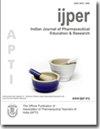微波辅助壳聚糖球磨美多索密的制备及全32因子优化
IF 0.8
4区 医学
Q3 EDUCATION, SCIENTIFIC DISCIPLINES
Indian Journal of Pharmaceutical Education and Research
Pub Date : 2023-08-23
DOI:10.5530/ijper.57.3s.64
引用次数: 0
摘要
引言:降压药物奥美沙坦酯(OLM)是一种BCS II药物,其作用是抑制血管紧张素II对AT1受体的作用。目的:本研究的目的是通过改变结晶形式来提高溶解度和稳定性,从而降低制药行业的成本和剂量负担。在目前的研究中,OLM制剂是通过使用以壳聚糖和neusiline为独立因素的全3水平2析因设计制备的。材料与方法:壳聚糖是一种亲水性、稳定性的聚合物,以新硅烷为表面活性剂,提高其溶解度和稳定性。采用微波辅助球磨技术制备配方。结果与讨论:相溶解度研究表明,与纯药物相比,三元混合物的饱和溶解度高出约12倍。红外光谱、差示扫描量热分析、扫描电镜、核磁共振研究证实了聚合物与OLM的物理相互作用。XRD证实了该药物改变的结晶形式,这可能会改变其溶解度和溶解速率。通过析因设计获得的优化批次用于电动球磨。这证明了溶解度、稳定性和溶解速率的显著提高。结论:因此,将壳聚糖与微波辅助球磨工艺相结合,可以在提高BSC II药物的生物利用度方面取得新的突破。本文章由计算机程序翻译,如有差异,请以英文原文为准。
Preparation and Optimization of Microwave-Assisted Ball-Milled Olmesartan Medoxomil with Chitosan Using Full 32 Factorial Design
Introduction: The anti-hypertensive drug Olmesartan Medoxomil (OLM), a BCS II drug, works by inhibiting the action of angiotensin II on AT1 receptors. Objectives: The purpose of the study was to enhance solubility and stability by altering crystalline form, which reduces cost and dose burden of the pharmaceutical industry. In the current study, OLM formulation was prepared by using a full 3 level 2 factorial design with chitosan and neusiline as independent factors. Materials and Methods: Chitosan, a hydrophilic and stabilizing polymer, was used to enhance solubility and stability with the help of neusiline as a surfactant. Formulation was prepare using microwave-assisted ball milled technology. Results and Discussion: In comparison to the pure drug, phase solubility study shows the ternary mixture's saturation solubility was around 12 times higher. Physical interaction between polymer and OLM was confirmed from the FTIR study, DSC graph, SEM surface morphological study and NMR study. The drug's altered crystalline form has been confirmed by XRD, which could alter its solubility and rate of dissolution. The optimized batch obtained from factorial design was used for electrically operated ball milling. This demonstrated a notable improvement in the solubility, stability, and dissolving rate. Conclusion: As a result, using chitosan with a microwave assisted ball milling process can be a novel breakthrough in enhancing the bioavailability of any BSC II medicines.
求助全文
通过发布文献求助,成功后即可免费获取论文全文。
去求助
来源期刊
CiteScore
1.40
自引率
0.00%
发文量
227
审稿时长
>12 weeks
期刊介绍:
The official journal of Association of Pharmaceutical Teachers of India (APTI) and is being published since 1967. IJPER, a quarterly publication devoted to publish reviews and research articles in pharmacy and the related disciplines of Pharmaceutical education. It mainly covers the articles of special interest, covering the areas of Pharmaceutical research, teaching and learning, laboratory innovations, education technology, curriculum design, examination reforms, training and other related issues. It encourages debates and discussions on the issues of vital importance to Pharmaceutical education and research. The goal of the journal is to provide the quality publications and publish most important research and review articles in the field of drug development and pharmaceutical education. It is circulated and referred by more than 6000 teachers, 40,000 students and over 1000 professionals working in Pharmaceutical industries, Regulatory departments, hospitals etc.

 求助内容:
求助内容: 应助结果提醒方式:
应助结果提醒方式:


